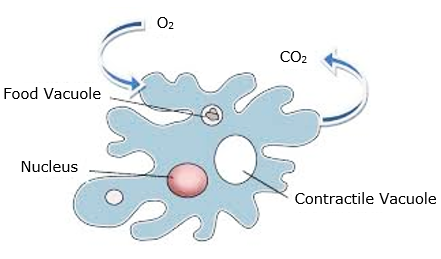How are nitrogenous wastes and water excreted in Amoeba?
Amoeba is a unicellular organism found in fresh water. Amoebas eat algae, bacteria, plant cells, and microscopic protozoa and metazoan – some amoebas are parasites. They eat by surrounding tiny particles of food with pseudo pods, forming a bubble-like food vacuole. The food vacuole digests the food. Wastes and excess water are transported outside the cell by contractile vacuoles. In amoeba carbon dioxide and ammonia are the main waster materials. These waste materials are excreted out by the process of diffusion through the general body surface. In amoeba, no excretory organs are present so contractile vacuoles function as an excretory unit. The waste materials present in the cytoplasm of amoeba enters the contractile vacuole. Then the contractile vacuole moves close to the plasma membrane, come in contact with the plasma membrane and burst to release its contents in the surrounding.

Explanation: The waste material carbon dioxide is removed by the process of diffusion though the cell membrane and the nitrogenous waste mainly ammonia is excreted with the help of the contractile vacuole. Specific excretory organs are absent in unicellular organisms like an amoeba. These organisms remove waste products by simple diffusion from the body surface into the surrounding water. Amoebas possess osmoregulatory (osmotic pressure) organelle called contractile vacuole. This collects water and waste from the body, swells up, reaches the surface and bursts to release its content to outside. The main excretion takes place through a body surface by the process of osmosis. Thus, waste products are exceeding in amoeba.